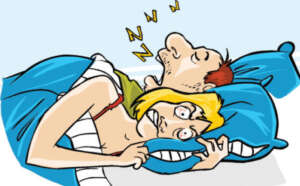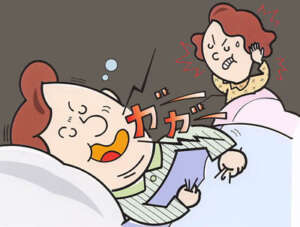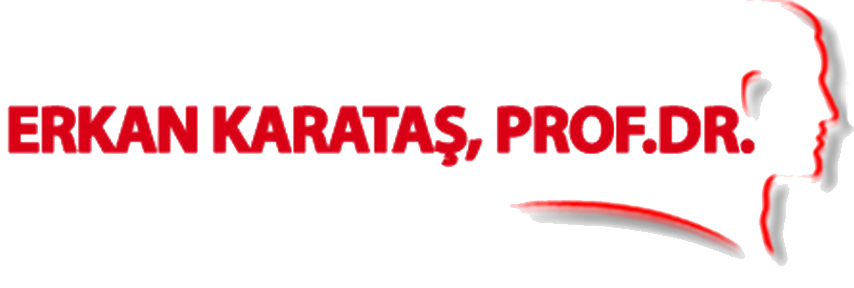OBSTRUCTIVE SLEEP APNE SYNDROME
Excessive snoring in sleep is a disease that eventually occurs inadequate and uncomfortable breathing in sleeping. Approximately 5-9% of people has breathing problems in sleep.

SNORING (OBSTRUCTIVE SLEEP APNE SYNDROME) CAN CAUSE SERIOUS HEALTH PROBLEMS • Forgetfulness, lack of attention• Hypertension• Heart attack• Heart rhythm disorder• Congestion after cerebral infarction• Difficulty in controlling diabetes• Decreased sexual performance• Traffic and work accidents and go asleep while driving or paying attention to a work
in Whom can be seen OBSTRUCTIVE SLEEP APNE SYNDROME?• In men (equalized after menopause)• At older ages (40-60)• When there is excess weight• Where the neck is thick• Smokers• Alcohol users• Sedative, antidepressant, sleeping pills, etc. In use• In a situation where it is difficult to breathe in the nose or throat (such as the nasal bone deviation, large tonsils and adenoids)
HOW OBSTRUCTIVE SLEEP APNE SYNDROME IS DIAGNOSED? • by analyzing a night sleep study (polysomnography) in the sleep laboratory.• During sleep study (polysomnography), your sleep status and abnormalities in your sleep due to your breathing exchange, rhythm of your heart, devices monitoring your blood oxygen level are observing by the electrodes that are stuck to your body with monitoring.• Data obtained using specially developed computer programs are analyzed and, while diagnosing, treatment options are determined on the one hand.

HOW OBSTRUCTIVE SLEEP APNE SYNDROME IS TREATED?• Weight loss can provide benefits.• Alcohol should not be taken in the evening hours.• Patients should not take the pills that effect the breathing in sleep.• Disorders that should be treated by surgery, should be performed. • The snoring reducing position is taken when sleeping.• Oral devices can be tried.• Continoous Positive Air Pressure (CPAP) application can be used while sleeping.
SURGICAL TREATMENTS IN OBSTRUCTIVE SLEEP APNEA SYNDROME
Nose
Increased nasal congestion has been shown to cause or contribute to snoring, disrupted sleep, and even sleep apnea. It is also a leading cause of failure of medical treatments for OSA, such as CPAP or an oral appliance. Nasal obstruction may result from many causes including allergies, polyps, deviated septum, enlarged adenoids, and enlarged turbinates.
Medical treatment options, such as a nasal steroid spray or allergy management, may be helpful in some patients. Structural problems, such as a deviated septum, often benefit from surgical treatment. One surgical option, known as radiofrequency turbinate reduction (RFTR), can be performed in the office under local anesthesia. RFTR uses radiofrequency to shrink swollen tissues in each side of the nose.
Upper throat (palate, tonsils, uvula)
In many patients with OSA, airway narrowing and collapse occurs in the area of the soft palate (back part of the roof of the mouth), tonsils, and uvula. The specific type and combination of procedures that are indicated depend on each individuals unique anatomy and pattern of collapse. Therefore the procedure selection and surgical plan must be customized to each patient. In general, these procedures aim to enlarge and stabilize the airway in the upper portion of the throat.
The surgery is performed in an operating room under general anesthesia, either as an outpatient or with an overnight hospital stay. The recovery varies depending on the patient and the specific procedures performed. Many patients return to school/work in approximately one week and return to normal diet and activity at two weeks. Throat discomfort, particularly with swallowing, is common in the first two weeks and usually managed with medications for pain and inflammation. Risks include bleeding, swallowing problems, and anesthesia complications, although serious complications are uncommon.
The tonsils and adenoids may be the sole cause of snoring and sleep apnea in some patients, particularly children. In children, and in select adults, with OSA and enlarged tonsils/adenoids , tonsillectomy/adenoidectomy alone can provide excellent resolution of snoring, sleep apnea, and associated symptoms.
Lower throat (back of tongue and upper part of voice box)
The lower part of the throat is also common area of airway collapse in patients with OSA. The tongue base may be larger than normal, especially in obese patients, contributing to blockage in this area. The tongue may also collapse backward during sleep as the muscles of the throat relax, particularly when some patients sleep on their back. The epiglottis, or upper part of the voice box, may also collapse and contribute to airway obstruction.
Multiple procedures are available to reduce the size of the tongue base or advance it forward out of the airway. Other procedures aim to advance and stabilize the hyoid bone which is connected to the tongue base and epiglottis. A more recent technology involves implantation of a pacemaker for the tongue (hypoglossal nerve stimulator) which stimulates forward contraction of the tongue during sleep. As with palatal surgery, the most appropriate type of procedure varies from one individual to another, and is primarily determined by each patients anatomy and pattern of obstruction.

The procedures are done under general anesthesia, often with overnight hospital observation. Recovery and risks vary depending on the procedure(s) performed, but are generally similar to procedures in the upper throat.
Skeletal procedures
For the most part, the above procedures involve surgical enlargement and stabilization inside the airway. For some patients, particularly those with developmental or structural changes of the jaw or other facial bones, surgical or orthodontic procedures on the bones of the face, jaw, or hard palate (roof of the mouth) may be beneficial.
Orthodontic procedures to widen the palate (palatal or maxillary expansion) may be useful treatment options in some pediatric patients. Maxillomandibular advancement surgery includes a number of procedures designed to move the upper jaw (maxilla) and/or lower jaw (mandible) forward, thus opening the upper and/or lower airway, respectively. Although full maxillomandibular advancement surgery can provide effective enlargement and stabilization of the airway, the potential benefits must be cautiously weighed against the potential increased risks of complications, longer recovery, and changes in the cosmetic appearance of the face.
.
TIKAYICI UYKU APNE SENDROMU
Uykuda aşırı horlama, yeterli ve rahat soluyamama, hatta zaman zaman nefes durması sonucu ortaya çıkan bir hastalıktır. Yaklaşık her 100 kişiden 5-9’unda uykuda nefes durması görülür.

HORLAMA (TIKAYICI UYKU APNE SENDROMU) CİDDİ SAĞLIK PROBLEMLERİNE
YOL AÇABİLMEKTEDİR
• Unutkanlık, dikkat eksikliği
• Yüksek tansiyon
• Kalp krizi
• Kalp ritm bozukluğu
• Beyin damarında tıkanıklık sonucu fel
ç
• Şeker hastalığı kontrolünün zorlaşması
• Cinsel performansta azalma
• Araba kullanırken veya dikkat gerektiren iş yaparken uyuklama sonucunda trafik ve iş kazaları
TIKAYICI UYKU APNE SENDROMU KİMLERDE SIK GÖRÜLÜR?
• Erkeklerde ( menopoz sonrası eşitlenir)
• İleri yaşlarda (40-60)
• Kilo fazlalığı olanlarda
• Boyun çevresi kalın olanlarda
• Sigara içenlerde
• Alkol kullananlarda
• Sakinleştirici, antidepresan, uyku ilacı vb. kullananlarda
• Burun veya boğazında nefes almayı zorlaştırıcı bir durum bulunanlarda (burun kemiği eğriliği, iri bademcik ve adenoid vb.)
TIKAYICI UYKU APNE SENDROMU TANISI NASIL KONUR?
• Uyku laboratuarında bir gece uyku çalışması (polisomnografi) yapılarak tanı konur.
• Uyku çalışması (polisomnografi) sırasında vücudunuza yapıştırılan elektrotlar sayesinde uyku durumunuzu ve nefes alışverişinizi, kalbinizin ritmini, kan oksijen düzeyinizi izleyen cihazlar sayesinde uykunuzda gelişen anormallikler izlenir.
• Özel olarak geliştirilmiş bilgisayar programları kullanılarak elde edilen veriler analiz edilir ve bir yandan tanı konurken bir yandan da tedavi seçenekleri belirlenir.
TIKAYICI UYKU APNE SENDROMU NASIL TEDAVİ EDİLİR?
• Kilo vermek yarar sağlayabilir.
• Akşam saatlerinde alkol alınmamalıdır.
• Uyku ilacı kullanılıyorsa uykuda solunumu etkilemeyenler kullanılmalıdır.
• Cerrahi olarak düzeltilebilecek bozukluklar tedavi edilir.
• Uyurken horlamayı azaltıcı pozisyon alınır.
• Ağız içi cihazlar denenebilir.
• Uykuda havayolunu açık tutan hava basıncı uygulaması (CPAP) yapılabilir.

TIKAYICI UYKU APNE SENDROMUNDA CERRAHİ TEDAVİ
Apne tedavisinde, ameliyat planı oluşturulurken tedaviye genellikle burun patolojilerini gidermekle başlanıp, sonrasında yumuşak damak, boğaz, dil kökü, gırtlak cerrahisi ve gerekli görülmesi durumunda ise daha ileri cerrahiler yapılmaktadır. Bu operasyondaki amaç, küçük dil ve yumuşak damak arkasındaki hava pasajının hacminin artırılması ve dokulardaki çökme eğiliminin azaltılmasıdır.
Damak bölgesinde esnekliğini kaybeden dokuların tekrar toparlanması için bu bölgenin gerginleştirilmesi amacıyla lokal anestezi altında (bulantı refleksi güçlü kişilerde genel anestezi tercih edilebilir) damağa radyofrekans uygulaması, küçük dilin kesilmesi gibi işlemlerle horlamanızı giderilebilir. Esnekliğini kaybeden damağın, daha doğru konumda kalması ve daha az titreşime neden olması amacıyla damağınıza implantlar yerleştirilebilir. Daha ciddi durumlarda genel anestezi altında, damağın sarkan kısımlarının toparlanması, boğazda çok yer kaplayan bademciklerin alınması ve bu bölgelerin dikişlerle toparlanmasından oluşan uvulopalatofaringoplasti (UPPP) ameliyatı ve lazer destekli uvulopalatoplasti (LAUP) yapılabilir.
Apne tedavisinde, dil köküne yönelik cerrahiler de uygulanmaktadır. Bunların arasında, dil kökü radyo frekans ve dil askısı tekniği uygulamaları; cerrahi, lazer, Coblator yöntemi ve son yıllarda uygulanan robotik cerrahi teknikleriyle dil kökünün küçültülmesi işlemleri yer almaktadır.

Daha ağır seyreden uyku-apne sendromunda, çene kemiklerini öne ilerletme ameliyatları uygulanır. Ancak bu yöntem, maske (CPAP) kullanmak istemeyen ağır hastalarda tercih edilir. Bu ameliyatta amaç, çenenin ilerletilerek, hava pasajının büyütülmesidir.
.


